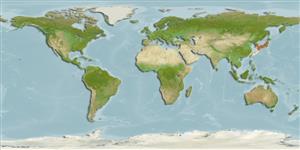| Native range | All suitable habitat | Point map | Year 2100 |

|
| This map was computer-generated and has not yet been reviewed. |
| Plecoglossus altivelis altivelis AquaMaps Data sources: GBIF OBIS |
Issue
All subspecies of Plecoglossus altivelis (Temminck & Schlegel, 1846) are synonymised under the species in Eschmeyer (CofF ver. Jul. 2010: Ref. 84883). Please send references, or more studies are needed.
Length at first maturity
Lm 20.0, range 30 - 40 cm
Human uses
Fisheries: highly commercial; aquaculture: commercial; gamefish: yes
Phylogenetic diversity index
(Ref. 82805)
PD50 = 1.5000 many relatives (e.g. carps) 0.5 - 2.0 few relatives (e.g. lungfishes)
Trophic Level
(Ref. 69278)
2.8 ±0.16 se; Based on food items.
Resilience
(Ref. 69278)
High, minimum population doubling time less than 15 months (tm=1; tmax=3; Fec=50,000-100,000)